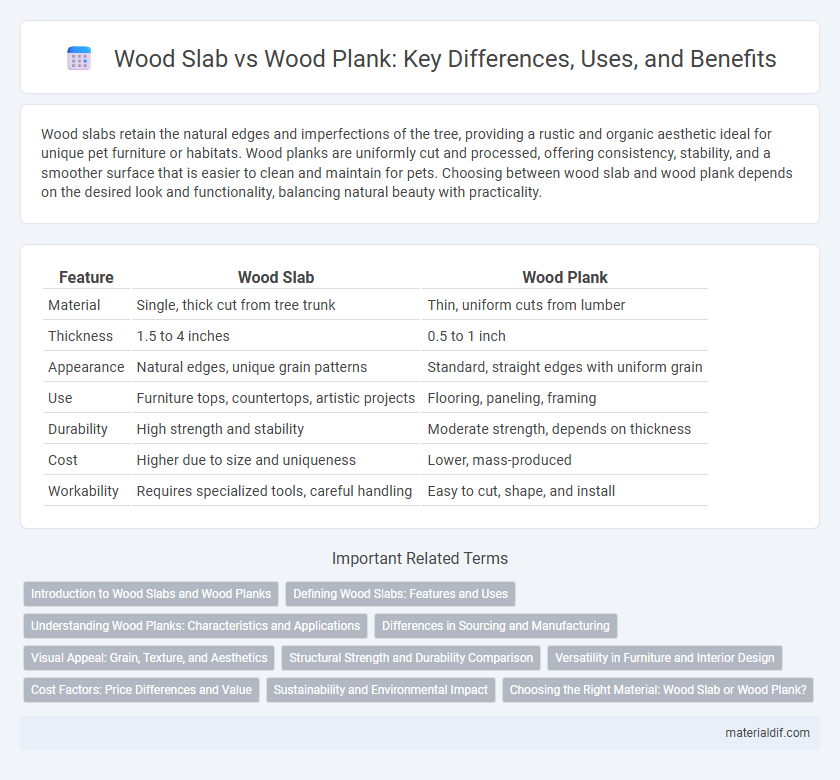Wood slabs retain the natural edges and imperfections of the tree, providing a rustic and organic aesthetic ideal for unique pet furniture or habitats. Wood planks are uniformly cut and processed, offering consistency, stability, and a smoother surface that is easier to clean and maintain for pets. Choosing between wood slab and wood plank depends on the desired look and functionality, balancing natural beauty with practicality.
Table of Comparison
| Feature | Wood Slab | Wood Plank |
|---|---|---|
| Material | Single, thick cut from tree trunk | Thin, uniform cuts from lumber |
| Thickness | 1.5 to 4 inches | 0.5 to 1 inch |
| Appearance | Natural edges, unique grain patterns | Standard, straight edges with uniform grain |
| Use | Furniture tops, countertops, artistic projects | Flooring, paneling, framing |
| Durability | High strength and stability | Moderate strength, depends on thickness |
| Cost | Higher due to size and uniqueness | Lower, mass-produced |
| Workability | Requires specialized tools, careful handling | Easy to cut, shape, and install |
Introduction to Wood Slabs and Wood Planks
Wood slabs are large, thick sections cut directly from a tree trunk, preserving natural edges and unique grain patterns, ideal for custom furniture and live-edge projects. Wood planks are thinner, more uniform boards typically milled for flooring, cabinetry, and construction, offering consistent dimensions and smoother surfaces. Choosing between slabs and planks depends on the desired aesthetic, structural requirements, and application in woodworking projects.
Defining Wood Slabs: Features and Uses
Wood slabs are thick, uncut sections of timber typically retaining the natural edge, showcasing unique grain patterns and knots that enhance their aesthetic appeal. Commonly used in furniture making, countertops, and decorative wall art, slabs provide a rustic, organic look that emphasizes natural beauty and durability. Their substantial thickness and size differentiate them from wood planks, which are thinner, more uniform, and often used for flooring or paneling.
Understanding Wood Planks: Characteristics and Applications
Wood planks are flat, rectangular pieces of lumber typically milled from logs with consistent thickness and smooth surfaces, making them ideal for flooring, furniture, and cabinetry. They offer uniformity and ease of installation due to their standardized dimensions and are available in various wood species such as oak, maple, and pine. The versatility of wood planks allows them to be used in both structural and decorative applications, providing strength and aesthetic appeal in residential and commercial projects.
Differences in Sourcing and Manufacturing
Wood slabs are cut directly from logs, preserving the natural edges and grain patterns, while wood planks are typically milled and planed into uniform dimensions. The sourcing of wood slabs often involves selecting whole or large sections of trees, making them ideal for custom or rustic furniture, whereas wood planks are produced in bulk from standardized lumber suitable for construction and flooring. Manufacturing slabs requires less processing but demands more careful drying to prevent warping, whereas planks undergo precise milling, drying, and sometimes chemical treatments to enhance durability and consistency.
Visual Appeal: Grain, Texture, and Aesthetics
Wood slabs showcase natural grain patterns and textures, often featuring unique knots and organic edges that create a rustic and authentic aesthetic. Wood planks offer uniform grain and smooth surfaces, providing a more polished and consistent look ideal for modern interiors. The choice between slabs and planks significantly influences the visual appeal, with slabs emphasizing natural beauty and planks ensuring sleek, refined aesthetics.
Structural Strength and Durability Comparison
Wood slabs offer superior structural strength due to their thicker, solid cross-section, making them ideal for heavy-duty applications such as flooring and furniture. Wood planks, typically thinner and narrower, provide greater flexibility but may require additional support to achieve comparable durability. The dense grain pattern and natural resistance to warping in slabs contribute significantly to their long-term durability over planks.
Versatility in Furniture and Interior Design
Wood slabs offer unparalleled versatility in furniture and interior design due to their natural, organic shapes and large surface areas, ideal for statement tables and custom countertops. Wood planks provide consistent dimensions and easy assembly, making them suitable for flooring, paneling, and modular furniture projects requiring precise alignment. Choosing between slabs and planks depends on design goals, as slabs emphasize uniqueness and character while planks focus on uniformity and practicality.
Cost Factors: Price Differences and Value
Wood slabs typically cost more than wood planks due to their larger size, natural edges, and limited availability, which add unique aesthetic value ideal for custom furniture and countertops. Wood planks are generally more affordable as they are easier to mass-produce, have uniform dimensions, and are widely available for flooring and paneling projects. The choice between wood slab and wood plank depends on balancing initial price differences against the desired design impact and long-term durability.
Sustainability and Environmental Impact
Wood slabs offer sustainability benefits by utilizing more of the harvested tree with less processing waste compared to wood planks, which require cutting into thinner, uniform boards, often generating more offcuts. The reduced manufacturing energy and lower emissions associated with slabs contribute to a smaller environmental footprint, making slabs a more eco-friendly option for furniture and construction. Sustainable sourcing certifications like FSC further enhance the environmental responsibility of choosing wood slabs over planks.
Choosing the Right Material: Wood Slab or Wood Plank?
Wood slabs offer natural, live edges and unique grain patterns, making them ideal for statement furniture and custom designs, while wood planks provide uniformity, ease of installation, and cost-effectiveness for flooring and paneling projects. Selecting wood slabs enhances aesthetic value and craftsmanship but may require more intensive finishing and maintenance compared to the versatility and consistent sizing of wood planks. Understanding the project's design goals, budget, and installation complexity is essential when choosing between wood slab and wood plank materials.
Wood Slab vs Wood Plank Infographic

 materialdif.com
materialdif.com